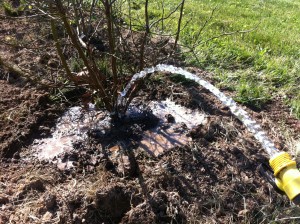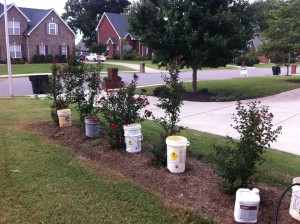You’re shopping at the garden center and something catches your eye. You purchase impulsively and take it home. You have found the right site and dig a proper hole for the future of your new investment. You even install it correctly. But wait!
Then you forget about it… for two days(or longer) and the leaves are dead. Burned to a crisp by drought stress (wilting). (I just did this with some annual Zinnia flowers. They will recover).
What happened? Learning Curve!!!
You didn’t water it! Or more appropriately, you didn’t irrigate correctly or effectively.
But wait, you say! I sprayed water over the stems and leaves for a good 30 seconds. I promise.
Irrigating the stems and leaves might make you feel good, like it’s cooling a shrub’s branches and leaves. But if you don’t reapply every few minutes, the lasting effects are minimal. The roots are the only thing that matter here.
Soak, then Allow to Dry
- Trees and shrubs grow best when they are soaked, then allowed to dry. Ebb and flow, just like rainfall, the ground is very wet, and soggy. Then the Sun comes out and the soil is baked dry.
- Roots grow away from the new plant into the soil in search of moisture. They won’t grow out unless they need water. If you’re over-irrigating, then the root stay put. They are fat and happy where they are.
- If no moisture is available, the plant will enter stress and decline. Keep them moist by soaking, then check with your finger daily.
Pro Irrigation Techniques
- First, buy a 3/4″ water hose. I don’t like anything in a smaller diameter. 1/2″ is bad. 5/8″ is bad. I like the premium quality hose, spend as much as you can afford. You pay for what you get.
- A new plant has 100% of its roots directly underneath the tree trunk or shrub stems.
Direct all the water there by dripping it from the garden hose. Spraying the water over the stems and leaves might make you feel good, but it’s not effective.
- The most effective and efficient way is to place the hose end directly on top of the new plants’ root ball.
A second, inexpensive way to irrigate new plants is with five gallon buckets. Use a drill bit and drill a small pin sized hole on one side of the bucket bottom. Fill the bucket with water from the garden hose and place the pin hole side near the root zone. All the water slowly flows to exactly where it’s needed.
- I love the bucket method because it’s temporary and portable. No need for a irrigation system or multiple hoses.
Efficiency
- Keep the area around the roots weed and grass free.
Grass sucks moisture from the soil like a straw. The less vegetation near your new tranplant, the more water it will keep for itself. Use a shovel to cut the grass, use mulch to smother grass, or use chemical herbicides to keep the invaders at bay.
- The more grass and weed-free space around the edges of your new plant’s root system, the better.
Do you have a great technique for irrigating plants? Please share it on the Facebook page.






